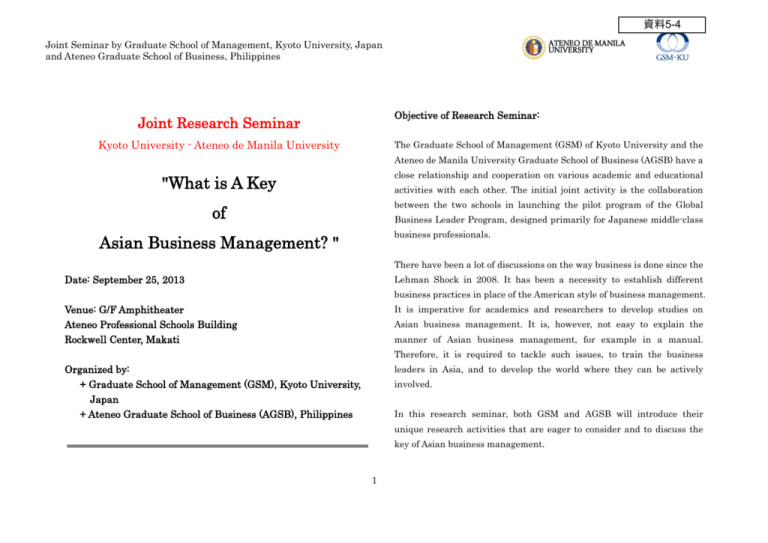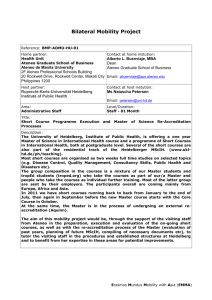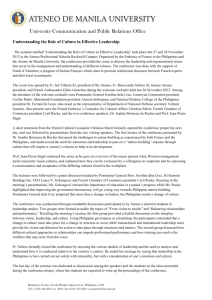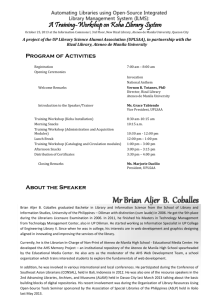Joint Research Seminar
advertisement

資料5-4 Joint Seminar by Graduate School of Management, Kyoto University, Japan and Ateneo Graduate School of Business, Philippines Objective of Research Seminar: Joint Research Seminar Kyoto University - Ateneo de Manila University The Graduate School of Management (GSM) of Kyoto University and the Ateneo de Manila University Graduate School of Business (AGSB) have a "What is A Key close relationship and cooperation on various academic and educational of between the two schools in launching the pilot program of the Global activities with each other. The initial joint activity is the collaboration Business Leader Program, designed primarily for Japanese middle-class business professionals. Asian Business Management? " There have been a lot of discussions on the way business is done since the Date: September 25, 2013 Lehman Shock in 2008. It has been a necessity to establish different business practices in place of the American style of business management. Venue: G/F Amphitheater Ateneo Professional Schools Building Rockwell Center, Makati It is imperative for academics and researchers to develop studies on Asian business management. It is, however, not easy to explain the manner of Asian business management, for example in a manual. Therefore, it is required to tackle such issues, to train the business Organized by: + Graduate School of Management (GSM), Kyoto University, Japan + Ateneo Graduate School of Business (AGSB), Philippines leaders in Asia, and to develop the world where they can be actively involved. In this research seminar, both GSM and AGSB will introduce their unique research activities that are eager to consider and to discuss the key of Asian business management. 1 Joint Seminar by Graduate School of Management, Kyoto University, Japan and Ateneo Graduate School of Business, Philippines Schedule: Program on Research Presentation 1:30 – 2:00 pm Registration and Opening remarks 2:00 – 2:30pm "ISO 9001.2000: How Effective is it as a Change 2:00 – 2:30 pm by Prof. Eliseo A. Aurellado, AGSB Strategy " by Prof. Eliseo A. Aurellado, AGSB Title: "ISO 9001.2000: How Effective is it as a Change Strategy" "J-L Puzzle Theory -Determining Jigsaw Puzzle Brief: 2:30 – 3:00 pm Type or Puzzle Links Type for Managerial Decision 3:00 – 3:30 pm 3:30 – 4:15 pm The growing globalization, which has rendered trade and commerce Making-" by Assoc. Prof. Yoshikazu MAEGAWA, GSM virtually borderless, has created awareness of the need to standardize the "Performance Evaluation of Branches of a commercial quality of products and services purveyed in the global market. ISO Bank in Northern Luzon Using Data Envelopment 9001.2008 (ISO) has been widely used by organizations as a quality Analysis " by Prof. Francisco L. Villanueva, Jr., AGSB management system to standardize products and services for greater "Ka-Ki-Ku-Ke-Ko” Businesses Will Save Local Regions" market acceptability. However, organizations vary in terms of results from the adoption of such a system. by Prof. Kiyoshi KOBAYASHI, GSM 4:15 – 4:30 pm Closing remarks The study, apart from establishing a correlation between ISO and Organization Development, measures the effectiveness of the quality management system as a change strategy especially as it relates to MSC, Registration (limited seats available, confirmation is required on or before Sept. 20): Ms. Jenifer Juayong Phone: 894-4868; 840-1247 Email: jen@cce.ateneo.edu Online: www.cce.ateneo.edu a medium-sized construction firm, and to selected construction companies in the Philippines. Results showed that the implementation of ISO produced positive results, such as improvements in processes, greater marketability, better communications and coordination, customer focus, and accountability. The continuous improvement ethos inherent in the ISO quality management system also encouraged innovation and change. As a general framework for managing and integrating organization-wide activities to achieve strategic goals and operational objectives, ISO is deemed useful. However, in spite of its perceived 2 Joint Seminar by Graduate School of Management, Kyoto University, Japan and Ateneo Graduate School of Business, Philippines benefits, ISO is not considered a panacea and by itself does not of bank branches. This paper attempted to develop a robust framework guarantee organizational effectiveness. It owes its effectiveness to for performance appraisal with the use of Data management’s commitment to support it. Envelopment Analysis (DEA), applying it to a bank branch network of a commercial bank in Northern Luzon. The application of the DEA model 2:30 – 3:00 pm by Assoc. Prof. Yoshikazu MAEGAWA, GSM consisted of 10 bank branches, and used both production and value-added Title: "J-L Puzzle Theory" or intermediation approaches. The use of these approaches identified the input and output inefficiencies in the bank branches. DEA was able to -Determining Jigsaw Puzzle Type or Puzzle Links Type for rank the branches using efficiency scores, identify areas of deficiency, Managerial Decision Making- Brief: Instead of “research and/or development,” this study proposes a new dichotomy for managerial decision making around technical tasks. and establish a reference group for evaluating their performance. In Jigsaw Puzzle Type : accomplishable with investing resources like personnels, money and time Puzzle Links Type : uncertain even with plenty of resources, and dependent heavily upon breakthroughs like innovative ideas or a serendipitous discovery findings can help management in diagnosing and making prescriptions addition, a cross tabulation of the results enabled the use of mapping techniques to plot the relative performance of the various branches. The for individual branches. The study also employed weight restrictions on the various models to improve their discriminatory properties. Empirical results indicated that DEA was able to present relative efficiencies of This dichotomy is totally independent with the conventional ones of “research and/or development,” rather, they are mutually orthogonal to form 2x2 matrix; Research and Jigsaw, Research and Links, Development and Jigsaw, and Development and Links. Each of the four cells requires an appropriate managerial decision making. units, and identify top performers. DEA was also able to prescribe 3:00 – 3:30 pm by Prof. Francisco L. Villanueva, Jr., AGSB models. Title: Performance Evaluation of Branches of a Commercial Bank in adjustments in the inputs and outputs of less efficient units to raise their efficiency to optimal. The production approach models exhibited greater discriminatory power over the intermediation models. Inclusion of weight restrictions also helped to improve the discriminatory powers of the DEA 3:30 – 4:15 pm by Kiyoshi KOBAYASHI, GSM Northern Luzon Using Data Envelopment Analysis Title: “Ka-Ki-Ku-Ke-Ko” Businesses Will Save Local Regions Brief: Competition in the banking industry has become more intense; thus, the importance to adopt more rational methods to evaluate the performance 3 Brief: Amongst 20th century regimes, developed countries enjoyed comparative Joint Seminar by Graduate School of Management, Kyoto University, Japan and Ateneo Graduate School of Business, Philippines superiority with regard to knowledge, research, education, and other human capital-intensive activities. As emerging countries continue to develop economically, a huge number of scientists and engineers who have received higher-level education in developed countries are gradually returning to their home countries. One might ask whether developed nations would enjoy a comparative superiority if there were no difference among countries’ quality of human capital and if all nations were able to provide the same added value, even to their remote regions. If Asian and African countries maintain their current growth rates, virtually every nation in the world will become a middle-income country sometime during the first half of this century. The importance of aid to developing countries based on two-nation discussions (as traditionally conducted) is sure to decline significantly. Global poverty will continue but will transform from an international problem into a domestic one. Aid must target not countries but, rather, diverse agents multi-nationally and cross-nationally. How will the resolution of poverty contribute to markets? It goes without saying that social businesses in “Ka-Ki-Ku-Ke-Ko” fields play an important role in the resolution of such domestic poverty issues. 4






